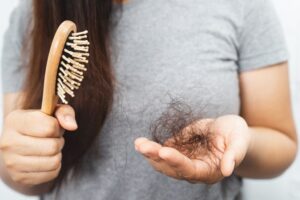


























New Hair Loss Study
Studio shows natural solutions for hair loss can work better than pharmaceuticals.
Are you suffering from hair loss? Then you'll want to read this.
STORY AT-A-GLANCE
September 25, 2023
Article from Dr. Mercola
Researchers from Korea compared lavender oil’s effects as a hair growth stimulant to the drug minoxidil (Rogaine) Lavender oil worked as well as minoxidil to significantly increase the number of hair follicles, deepen hair follicle depth and thicken the dermal layer.
In another study, massaging a mixture of essential oils, including lavender, into the scalp daily led to improvements in 44% of alopecia areata patients, compared to 15% of those in the control group.
Traditionally, lavender oil is used for stress relief and fatigue, and evidence suggests it may be effective for cellular growth, skin reproduction and alopecia areata, an autoimmune disease that causes hair loss.
Peppermint oil also works “remarkably” well to promote hair growth compared to saline and jojoba oil, and regrows hair “even faster than” minoxidil. A healthy head of hair is widely regarded as a sign of beauty and vitality. So, for the signicant number of men and women who experience hair loss and hair thinning, negative psychological consequences, including low self-esteem, anger and depression,1 are common.Hair also serves some important biological purposes, including cushioning your head against blows, keeping your scalp warm and providing a natural cover from excess sun.
Heavy metals, including arsenic, mercury and zinc, are also excreted in your hair, serving as a detoxication aid.
With hair loss having effects that are more than skin deep, researchers have been on the hunt for products to stimulate hair growth. Here nature once again provides, with lavender oil coming out on top against the hair loss drug minoxidil (Rogaine).
Researchers Pit Lavender Oil Against FDA-Approved Hair Drug
In a study on mice, researchers from Korea set out to determine lavender oil’s effects as a hair growth stimulant compared to minoxidil, a drug approved by the U.S. Food and Drug Administration that’s the most common treatment for androgenetic alopecia, a common form of hair loss.
There are three cycles of hair growth.2
The anagen phase is the growth phase in which the matrix cells of the hair follicle are fully pigmented and undergoing vigorous growth activities.
Catagen is the resting phase, when activity decreases.
In the third phase, telogen, the hair detaches from the follicle and falls out.
During normal hair cycles, about 90% of hair follicles are in the anagen phase, 1% are in the catagen phase and 9% are in the telogen phase.
In the case of pattern hair loss, “There appears to be a dysfunction and imbalance in hair cycling, resulting in a reduced length of anagen phase, increased proportion of hair in catagen/telogen phase and a shift toward the production of ne, short hairs,” researchers explained in Clinical, Cosmetic and Investigational Dermatology.3
Topical minoxidil works by inducing resting hair follicles into the anagen phase, shortening the telogen phase and prolonging the anagen phase. This leads to an increase in hair follicle volume.4
Lavender oil, meanwhile, also has a number of active effects, due to compounds including linalyl acetate — which relaxes nerves — linalool, an antifungal, and geraniol. Traditionally, lavender oil is used for stress relief and fatigue, and evidence suggests it may be effective for cellular growth, skin reproduction and alopecia areata, an autoimmune disease that causes hair loss.5
Lavender Oil Works Better Than Rogaine for Hair Growth
For the Korean study, researchers applied lavender oil at concentrations of 3% or 5%, with minoxidil or jojoba oil as a control to the fur of mice ve times a week for four weeks. Both lavender oil groups as well as the minoxidil group had a signicantly increased number of hair follicles, deepened hair follicle depth and thickened dermal layer.6
“These results indicated that LO [lavender oil] has a marked hair growth-promoting effect, as observed morphologically and histologically ... Thus, LO could be practically applied as a hair growth-promoting agent,” the researchers noted.7
Past research has found aromatherapy using lavender oil increased hair growth rates in people with alopecia areata.8 Massaging a mixture of essential oils, including lavender, into the scalp daily led to improvements in 44% of alopecia areata patients, compared to 15% of those in the control group.
“Treatment with these essential oils was signicantly more effective than treatment with the carrier oil alone,” researchers wrote in Archives of Dermatology.9
Peppermint Oil Also Promotes Hair Growth
Treatments for hair loss are limited and those that are available are saddled with risks. Minoxidil, which was originally created as a drug for high blood pressure, may cause increased heart rate, diculty breathing, weight gain, edema and dermatitis, itching and scaling of the scalp.10
Nontoxic support for hair loss is therefore urgently needed, and, along with lavender oil, peppermint oil is one such option. In a similar study on mice, researchers applied minoxidil, jojoba oil, saline or 3% peppermint oil to mice for four weeks.
Out of all the treatments, peppermint oil worked best, leading to the “most prominent hair growth effects.” This included a signicant increase in dermal thickness, follicle number and follicle depth. Two biomarkers for enhanced hair growth — alkaline phosphatase and gene expression of insulin-like growth factor-1 — also signicantly increased.
Not only did peppermint oil “remarkably” promote hair growth compared to saline and jojoba oil, but it did so “even faster than” minoxidil.11
“These results suggest that PEO [peppermint oil] induces a rapid anagen stage and could be used for a practical agent for hair growth,” the team explained.12 One way it works to promote hair growth is by relaxing vascular muscle, promoting blood circulation.13
Onion Juice Reverses Thinning Hair
Hair loss has complex underlying causes. It can occur with age and genetic factors, but stress and nutritional imbalances also play a role.14 In the case of alopecia areata, however, the immune system attacks healthy hair follicles, leading to varying degrees of hair loss.
Both genetics and environmental factors play a role in this autoimmune condition, but in the early stage, alopecia areata is associated with inammation in the upper dermis skin layer.15 As such, topical garlic16 and onion juice may help. In one study, 23 people with alopecia areata applied onion juice twice daily for two months.
A control group of 15 people applied tap water over the same period. Signicant differences were found, with onion juice leading to regrowth of terminal coarse hairs — the type that grows on your scalp and forms your eyelashes and eyebrows — after just two weeks.
By four weeks, 73.9% of those applying onion juice had hair re-growth, which increased to 86.9% by week six. Signicantly more men (93.7%) experienced hair regrowth than women (71.4%). For comparison, only 13% of those in the tap water group had hair regrowth.17
“The present study showed that the use of crude onion juice gave signicantly higher results with regard to hair regrowth than did tap water (P<0.0001), and that it can be an effective topical therapy for patchy alopecia areata,” the researchers concluded.18
Onion juice’s effectiveness of 86.9% is better than that of commonly used topical and systemic therapies for alopecia areata, including BCG immunotherapy, which has an effectiveness rate of 69%, and topical immunotherapy, which is 58% effective.19
Onions are rich in anti-inammatory quercetin, which also enhances the expression of the antioxidant enzyme catalase20 in your scalp. This helps break down hydrogen peroxide that contributes to cell damage and thinning hair.21
Antigenic competition — the inhibition of the immune system’s response to one antigen when another antigen is administered — may also help explain onion’s hair growth-stimulating effects. According to the team:22
“Previous reports have stated that onion can induce allergic contact dermatitis in some individuals; however, more recent studies showed that onion extract can inhibit skin allergic reactions, suggesting that onion juice may induce an immunological reaction, possibly as a mild form of dermatitis that can stimulate hair re-growth through antigenic competition.
If there were a relative lack of T-suppressor cells in the lymphocytic inltrate of alopecia areata, the generation of non-specic T-suppressor cells might inhibit the ongoing autoimmune reaction. Another possible mechanism, is that onions belong to the genus Allium, which is rich in sulphur and phenolic compounds, both of which are known skin irritants. Onion may cause an irritant contact dermatitis.”
Three More Natural Options for Hair Loss
Applying potentially toxic topical drugs to your scalp is not the only option to stimulate hair growth. Other nontoxic options include:
1. Ginseng — This herb and its active compounds ginsenosides are known to promote hair growth.23 They help regulate the expression and activity of proteins involved in hair-cycling phases, including the induction of anagen and delaying of catagen phases.24
2. Pine bark extract — This natural compound is heralded for its ability to improve hair density. A double blind, randomized, placebo‐controlled study revealed pine park extract increased hair density by 30% among postmenopausal women after two months of treatment, and 23% after six months, with researchers suggesting it “might have the potential to reduce hair loss in postmenopausal women.”25
3. Scalp massage — The relaxing stretching of skin on your scalp is a form of mechanical stress that may lead to increased hair thickness.26 Adding diluted rosemary oil to your scalp massage may improve results even more, with research showing it also works as well as minoxidil to increase hair count in people with hair loss.27
If you prefer, lavender oil or peppermint oil can also be used.
Nutritional factors should also be considered.
When researchers assessed patients from the Center for Dermatology and Hair Diseases who arrived with complaints of hair loss, they found that 38% of the women had a biotin deciency.28
Biotin is a cofactor for an enzyme that is crucial in the metabolism of glucose, fatty acids and amino acids. It’s also used in the production of hormones and cholesterol.29
You can find biotin in spinach, broccoli and sweet potatoes, as well as egg yolks, organ meats and dairy products. Malnutrition, iron deciency anemia and thyroid disease are also linked to hair loss, as is telogen euvium, which is when hair falls out after a major body stress. Side effects from some drugs, medical illness and a fungal infection of the scalp can also cause hair loss. So, while applying lavender and peppermint oils, and onion juice, topically may help to support hair regrowth, it’s important to assess the underlying reasons why your hair is falling out, and seek a comprehensive lifestyle strategy to resolve it.
Sources and References
1, 4, 5, 6, 7 Toxicol Res. 2016 Apr; 32(2): 103–108
2, 3 Clinical, Cosmetic and Investigational Dermatology, 2017
8 Gülhane Tıp Derg 2015;57: 233–23
9 Arch Dermatol. 1998 Nov;134(11):1349-52. doi: 10.1001/archderm.134.11.1349
10 Toxicol Res. 2014 Dec; 30(4): 297–304
11, 13 Toxicol Res. 2014 Dec; 30(4): 297–304., Discussion
12 Toxicol Res. 2014 Dec; 30(4): 297–304., Abstract
14 Toxicol Res. 2016 Apr; 32(2): 103–108., Intro
15 Australas J Dermatol. 2013 Aug;54(3):184-91. doi: 10.1111/ajd.12065. Epub 2013 Jun 28
16 J Clin Aesthet Dermatol. 2020 Aug; 13(8): 23–27
17 J Dermatol. 2002 Jun;29(6):343-6. doi: 10.1111/j.1346-8138.2002.tb00277.x
18 J Dermatol. 2002 Jun;29(6):343-6. doi: 10.1111/j.1346-8138.2002.tb00277.x, Abstract
19, 22 J Dermatol. 2002 Jun;29(6):343-6. doi: 10.1111/j.1346-8138.2002.tb00277.x, Discussion 20 Molecules. 2019 Mar; 24(6): 1123., Section 2.2
21 Woman’s World July 23, 2023
23 Int J Mol Sci. 2018 Sep; 19(9): 2703
24 Int J Mol Sci. 2018 Sep; 19(9): 2703., Conclusions
25 Health Sci Rep. 2023 Jan; 6(1): e1045
26 Eplasty. 2016; 16: e8
27 Skinmed. 2015 Jan-Feb;13(1):15-21
28 International Journal of Trichology, 2016;8(2)
29 National Institutes of Health, Biotin
#hairloss#alopeciaareata#alopecia#covidhairloss#hairrestoration#patternhairloss#treatmentsforhairloss
